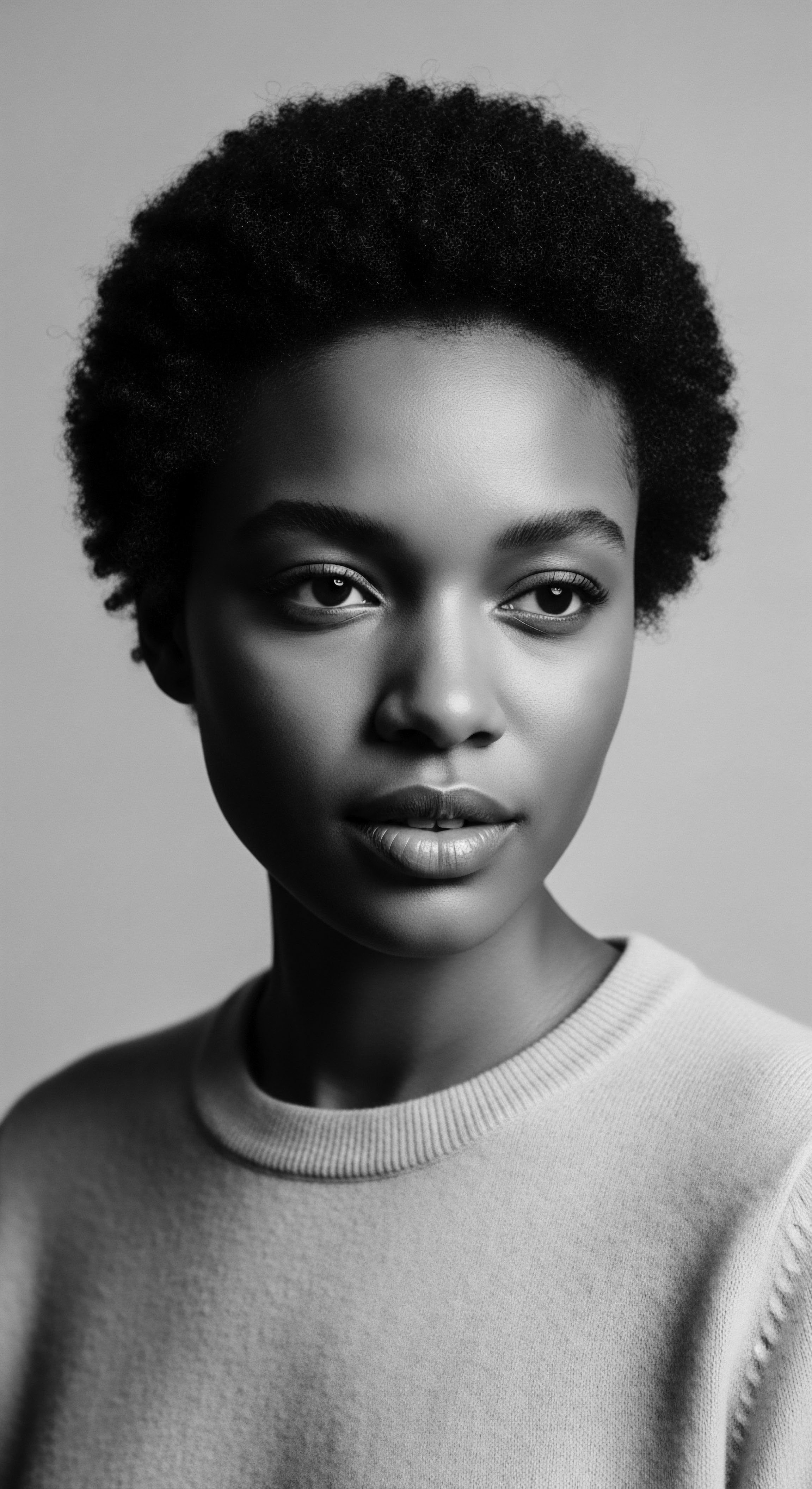
Roots
For generations, the coil and the kink, the wave and the curl, have graced heads across sun-drenched lands, not merely as adornment, but as a living legacy. One might find themselves gazing upon a vibrant head of textured hair, perhaps in the bustling markets of West Africa or the sun-kissed villages of the Caribbean, and wonder ❉ does this crown, so rich in form and heritage, offer a natural shield against the sun’s persistent gaze? This query, so seemingly straightforward, unfurls a profound exploration into the very physical makeup of textured hair, its ancestral story, and the wisdom held within each strand, a wisdom often passed through hushed tones and knowing hands across countless sunrises.

The Architecture of Ancestry
The journey to understanding how textured hair might protect against the sun begins at the cellular level, in the deep recesses of the hair follicle—a miniature organ of profound biological artistry. Unlike straight hair, which typically emerges in a circular cross-section, textured hair often presents with an elliptical or even flattened cross-section. This shape, in conjunction with the distribution of disulfide bonds within the hair’s cortex, dictates the curl’s tight embrace, forming helixes that spiral and coil. This inherent architectural distinction, a hallmark of our inherited lineage , profoundly shapes how light, including harmful ultraviolet (UV) radiation, interacts with the hair shaft.
Each individual strand is a universe, a cylindrical marvel composed of three primary layers. The outermost, the Cuticle, resembles overlapping shingles, forming a protective barrier. Beneath this lies the Cortex, the hair’s very heart, where keratin proteins and melanin granules reside, giving hair its strength and color. At the core, sometimes absent in finer hair, rests the Medulla.
The cuticle layers in textured hair, particularly tighter coils, may lie less uniformly flat than in straight hair. This unique arrangement might, in theory, create more surfaces for UV light to scatter and deflect, diminishing direct penetration to the delicate inner cortex. This structural characteristic hints at an intrinsic, biological aspect of sun defense, cultivated over millennia of human life in varied climates.
Textured hair’s distinctive elliptical cross-section and helical structure suggest an intrinsic, ancestral design for interacting with environmental light.

Melanin’s Ancient Shield
Within the cortex resides Melanin, the pigment that lends hair its hue. Textured hair, predominantly found in populations of African and diasporic descent, typically possesses a higher concentration of eumelanin, a dark, granular pigment. Eumelanin is a known absorber of UV radiation. This pigmentation, therefore, functions as a biological filter, intercepting harmful rays before they can damage the keratin structure or reach the scalp.
The greater the density of these melanin granules, the more pronounced this natural, internal defense mechanism becomes. This is a powerful echo of our ancestors’ profound adaptation to sun-drenched landscapes, a testament to the wisdom coded within our very cells.
Consider the journey of humankind, originating under the equatorial sun. Over countless generations, physiological adaptations, including skin tone and hair texture, developed as protective measures. The deep, rich hues prevalent in many textured hair types are not merely aesthetic; they speak to a biological imperative, a story of survival woven into every strand.
This intrinsic defense system, refined over millennia, represents a legacy that stretches far beyond modern sunscreens and hats. It is a reminder that protection can be as inherent as our very being, a gift from those who walked before us.

The Density Question ❉ A Protective Canopy?
Beyond the individual strand, the collective density of textured hair on the scalp may also contribute to sun protection. Hair that grows densely, forming a thick, compact mass, creates a natural canopy. This communal aspect of hair, how individual strands come together to form a collective shield, is often apparent in natural styles that allow hair to flourish in its unconstrained form.
A tightly coiled afro, for instance, naturally presents a formidable barrier to direct sunlight, a living textile woven by nature itself. This idea aligns with historical practices where hair, kept voluminous and well-maintained, was intrinsically linked to personal well-being and environmental resilience.
The interplay of these factors—the elliptical shape, the cuticle’s unique arrangement, the abundance of eumelanin, and the potential for collective density—paints a compelling picture of textured hair as a guardian against the sun. This is not a passive protection, but an active, biological shield, a silent promise whispered from one generation to the next, a deep knowing embedded in the very architecture of our being.
- Eumelanin Concentration ❉ Often higher in textured hair, acting as a natural UV absorber within the hair shaft.
- Elliptical Cross-Section ❉ Differs from rounder straight hair, influencing how light scatters and reflects off the strand.
- Cuticle Arrangement ❉ May present more varied surfaces for UV light interaction due to coiling, potentially reducing direct penetration.
- Collective Density ❉ Densely packed coils can form a substantial physical barrier, reducing direct scalp exposure.
This innate protection speaks to a profound connection between our physical being and the environments our ancestors navigated. It is a reminder that our hair, in its myriad forms, carries ancestral wisdom, often silently guarding us from the elements.
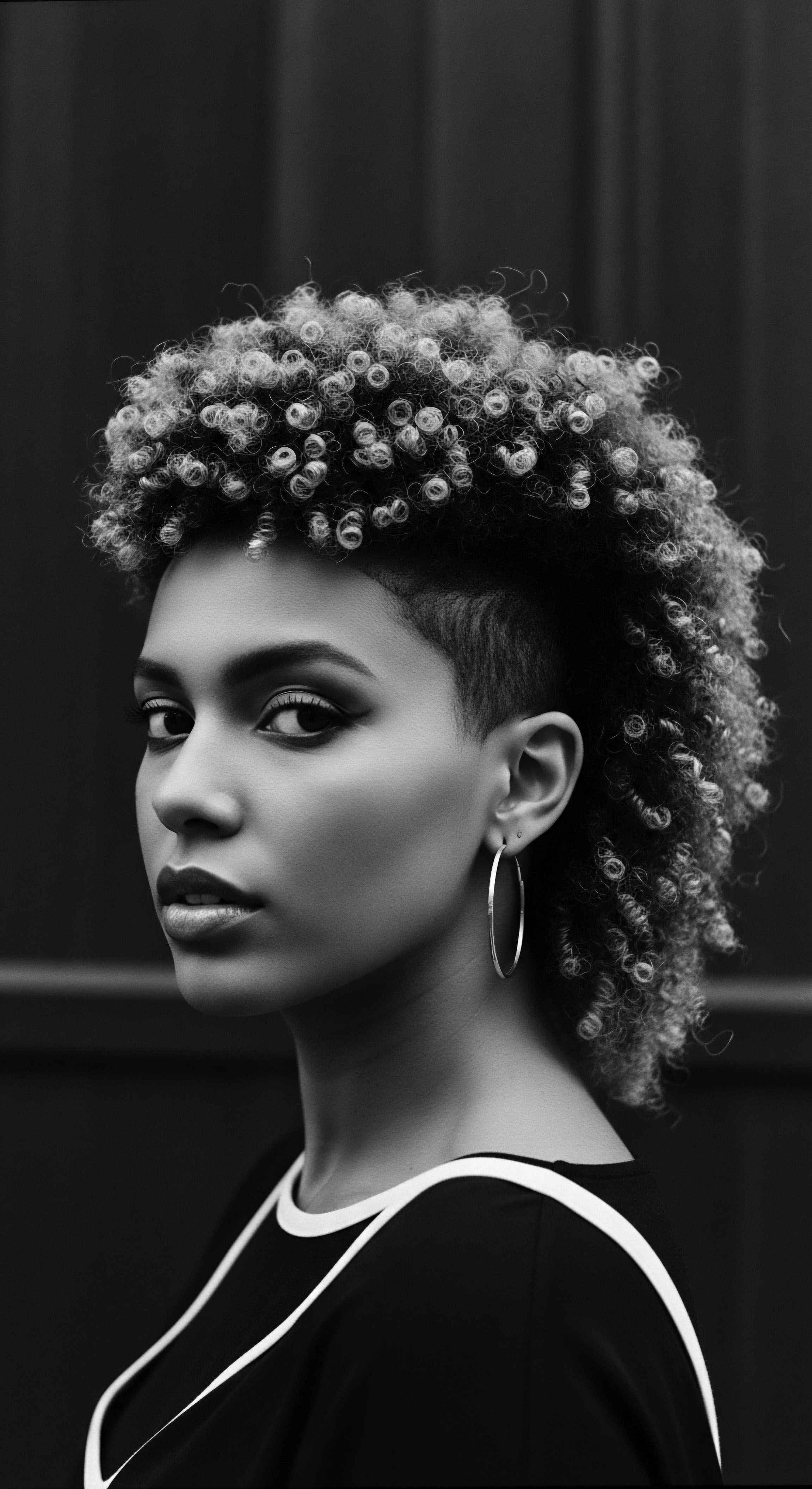
Ritual
The story of textured hair and sun protection extends beyond intrinsic biology; it flows into the realm of human ingenuity, woven into the very fabric of daily life and ancestral practices. For millennia, before the advent of modern science, communities relied on observation, handed-down knowledge, and the careful shaping of hair to navigate their environments. These traditional approaches, imbued with practical wisdom and cultural meaning, often served a dual purpose ❉ beautification and defense against the elements, including the relentless sun. The way hair was styled, cared for, and adorned speaks volumes about this deep connection between human ritual and environmental harmony.

Styling as Shield ❉ An Ancestral Imperative
Consider the myriad protective styles that have graced Black and mixed-race heads across generations—braids, twists, cornrows, and buns. These are not merely aesthetic choices; they represent a lineage of deliberate action, a sophisticated understanding of how to manipulate hair for its well-being and for the protection of the scalp. By gathering strands into cohesive, compact formations, these styles effectively minimize the surface area of hair directly exposed to the sun’s rays.
The scalp, particularly vulnerable to UV damage, becomes shielded by the hair itself, forming a natural, breathable cap. This tradition of protective styling is a living archive of ancestral innovation, born from necessity and refined into an art form.
From the intricate patterns of West African cornrows, which varied in meaning and design, to the robust braided styles of the Caribbean, often maintained with natural oils and butters, these techniques safeguarded the hair’s integrity while offering a tangible barrier against solar radiation. The consistent pulling and grouping of hair in these styles could also reduce friction and tangling, minimizing breakage and promoting length retention, further preserving the hair’s overall health and protective capacity. These methods were not recorded in textbooks; they were etched into hands, memorized by eyes, and passed down through the gentle, rhythmic acts of hair grooming—a tender thread connecting generations.
Protective styling, an ancient practice, served not just beauty but also as a vital, often ingenious, shield against the sun for both hair and scalp.
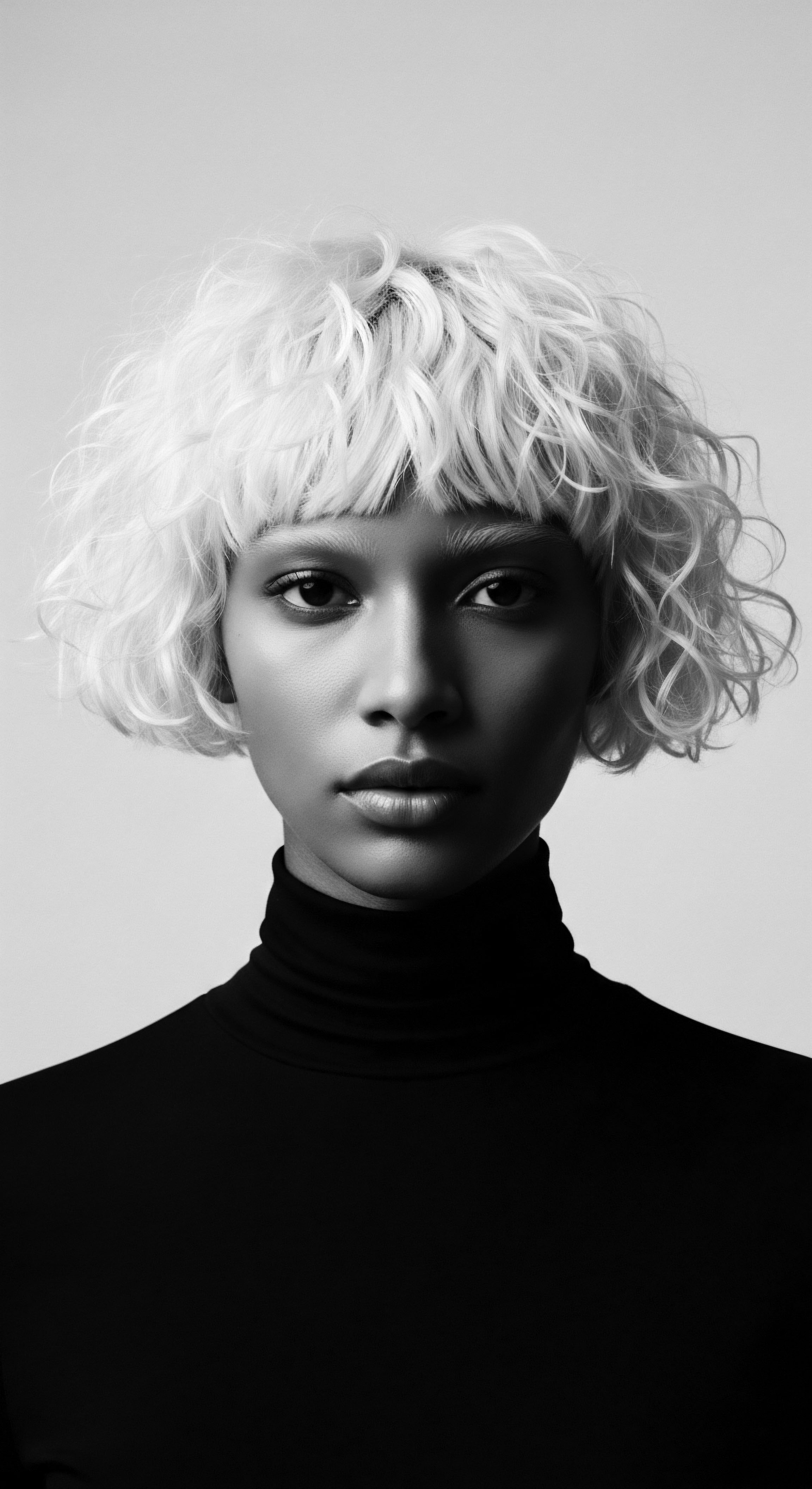
The Apothecary of Our Ancestors ❉ Ingredients of Defense
Parallel to styling, the application of natural oils, butters, and plant extracts formed a central tenet of ancestral hair care. Ingredients such as Shea Butter, Coconut Oil, and various botanical infusions, often sourced locally, were not chosen arbitrarily. They were selected for their perceived and often scientifically validated properties ❉ moisturizing, strengthening, and indeed, offering a degree of physical protection. While these natural emollients do not possess the high SPF factors of modern sunscreens, their role in creating a physical barrier and maintaining hair health cannot be overstated.
Shea butter, for instance, derived from the nuts of the African shea tree, has long been revered for its nourishing qualities. When applied to hair, it creates a subtle film that can help reduce moisture loss, a common issue under sun exposure, and potentially reflect some UV light. Similarly, certain natural oils possess inherent, albeit low, SPF properties.
The regular application of these substances, a ritual of deep care, helped maintain the hair’s natural resilience, allowing it to withstand environmental stressors more effectively. These traditions speak to a holistic approach to wellness, where hair was not separated from the body or its surroundings, but seen as an integral part of one’s entire being and connection to the earth.

Traditional Hair Protectants and Their Contributions
| Traditional Practice/Ingredient Protective Hairstyles (Braids, Twists, Wraps) |
| How It Contributes to Protection Minimizes direct exposure of individual strands and scalp to UV radiation; reduces tangling and breakage. |
| Traditional Practice/Ingredient Shea Butter (Vitellaria paradoxa) |
| How It Contributes to Protection Forms a physical barrier, reduces moisture loss, and offers mild natural UV filtering properties. |
| Traditional Practice/Ingredient Coconut Oil (Cocos nucifera) |
| How It Contributes to Protection Penetrates the hair shaft to reduce protein loss; provides a light protective coating against environmental damage, including some UV. |
| Traditional Practice/Ingredient Plant-Based Rinses/Infusions (e.g. Hibiscus) |
| How It Contributes to Protection Adds strength and conditioning, potentially improving hair's resilience to sun-induced damage. |
| Traditional Practice/Ingredient These heritage methods reflect a deep understanding of hair's needs within specific environmental contexts. |

The Wisdom of Covering ❉ Head Wraps and Their Legacy
Beyond styling and product use, the practice of head wrapping, particularly prevalent in many African and diasporic cultures, stands as a prominent historical method of sun protection. Head wraps, fashioned from various fabrics, served as both a cultural statement and a supremely practical shield. They offered comprehensive coverage for the entire head, including the delicate scalp, forehead, and often the neck, providing an immediate and effective physical barrier against the sun. The sheer variety of wrapping styles and fabrics speaks to regional adaptations and aesthetic expressions, all underpinned by a fundamental protective purpose.
From the vibrant geles of Nigeria to the dignified turbans of West Africa and the Caribbean, head wraps were a ubiquitous part of daily life. They protected against harsh sun, dust, and environmental elements, preserving hair’s moisture and preventing damage. This practice is a powerful symbol of resilience and self-preservation, a legacy of communities thriving under the sun, understanding intuitively how to dress their crowns for both reverence and protection. It is a historical testament to a conscious, collective decision to honor and guard one’s textured hair and the person beneath it.
The rituals of hair care and styling, steeped in ancestral wisdom, extend the inherent protective capabilities of textured hair. They are not merely acts of grooming; they are acts of cultural continuity, expressions of a deep historical bond between people, their environment, and the living archive that is their hair.
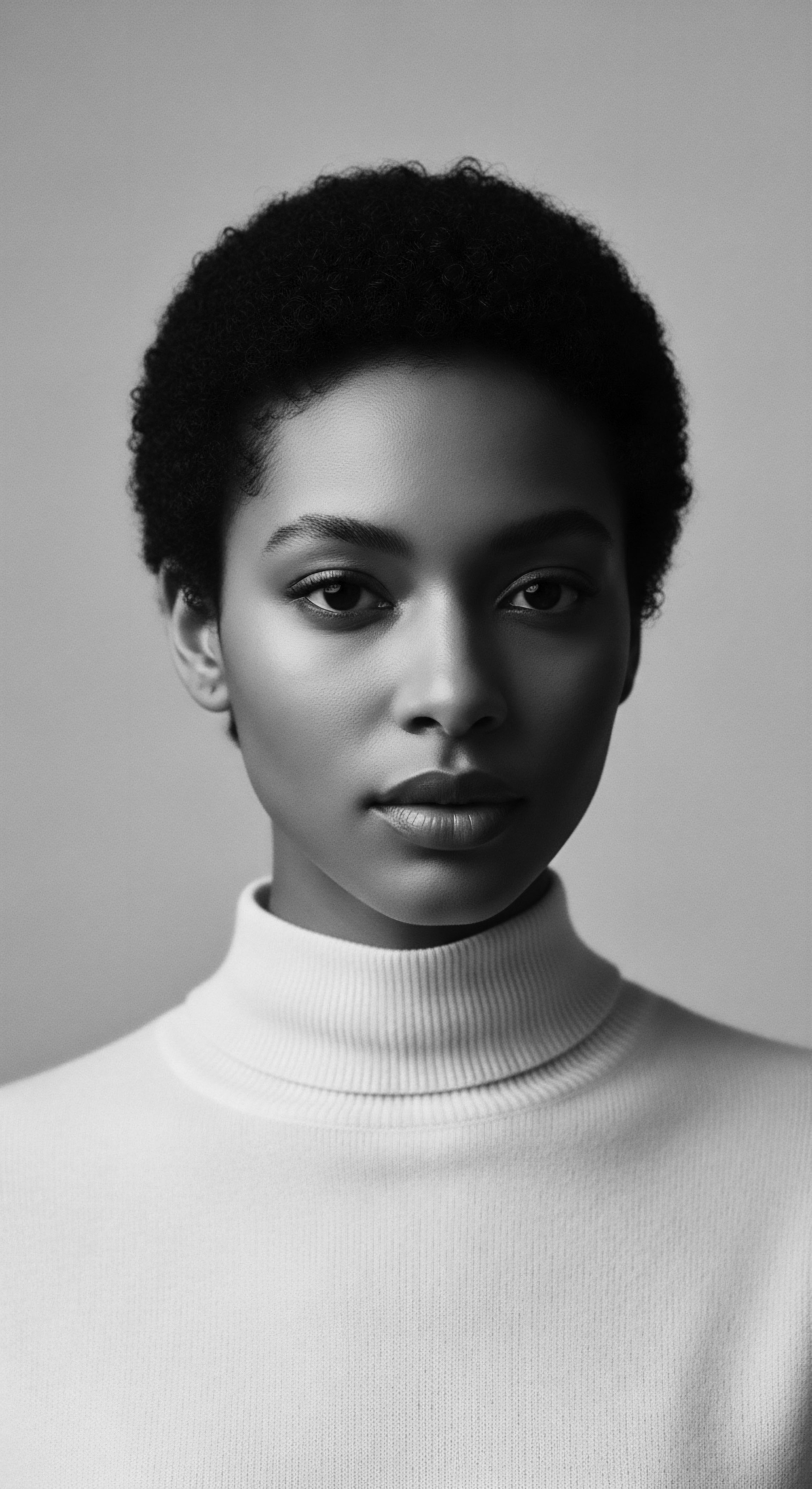
Relay
The inquiry into textured hair’s potential for sun protection bridges the ancient wisdom of our forebears with the rigorous lens of contemporary science. It is a dialogue between tradition and discovery, where modern understanding often illuminates the profound ingenuity embedded within ancestral practices. This deeper exploration moves beyond anecdotal observation, seeking to quantify and explain the protective mechanisms inherent in the unique structure of coiled, kinky, and wavy hair, always anchoring these findings to the enduring legacy of textured hair heritage .

The UV Challenge and Hair’s Vulnerability
Ultraviolet radiation, a component of sunlight, is known to damage hair in several ways. UVA and UVB rays can break down the protein structure (keratin) of the hair shaft, leading to issues such as increased porosity, decreased strength, color fading, and general degradation of the hair’s integrity. These changes render hair more brittle, dull, and prone to breakage.
For all hair types, prolonged sun exposure poses a challenge. The question, then, is whether the unique morphological characteristics of textured hair confer a particular advantage in mitigating these detrimental effects, a question often pondered by those mindful of hair’s ancestral resilience.

Does Curl Pattern Offer Superior UV Shielding?
The distinct geometry of textured hair, particularly tighter curl patterns, has been hypothesized to offer enhanced sun protection. The helical coiling creates a natural labyrinth, a series of twists and turns that may impede the direct penetration of UV rays to the hair’s inner cortex and, crucially, to the scalp. Consider a tightly wound spring versus a straight rod; the spring presents a far more complex surface for light to navigate, potentially causing more scattering and absorption before reaching deeper layers. This architectural complexity might act as a diffuse filter, dispersing UV energy across a wider area of the hair shaft, thus reducing localized damage hotspots.
While definitive, large-scale studies directly comparing the SPF equivalence of varying hair textures are still limited, existing research provides intriguing insights. A study by Robbins (2012) explored the effects of UV radiation on hair and noted that the physical structure of hair, alongside its melanin content, plays a role in its photoprotection. He observed that hair’s inherent capacity to absorb and reflect UV light is influenced by its structural characteristics. While not explicitly quantifying differences between textures, this work underscores the importance of physical form in defense.
The very density and way in which strands aggregate in tightly coiled hair creates a formidable, intertwined barrier. This collective shielding, where individual curls overlap and nestle together, forms a canopy that significantly reduces the direct path for sunlight to reach the sensitive scalp.

Key Structural Elements and Protective Hypotheses
- Helical Coiling ❉ The spiraling shape of textured hair may cause UV rays to scatter and diffuse, reducing direct penetration to the hair shaft’s interior.
- Increased Surface Area ❉ The numerous bends and curves of textured strands present a greater total surface area for UV interaction, potentially distributing damage more widely.
- Overlap and Density ❉ Tightly packed coils and high hair density act as a physical mesh, preventing direct solar access to the vulnerable scalp.

Melanin’s Role in Photoprotection ❉ A Deeper Look
The photoprotective properties of melanin, particularly eumelanin, are well-established in dermatological science concerning skin. Its function in hair, while distinct, operates on similar principles. Eumelanin efficiently absorbs broad-spectrum UV radiation, converting it into heat, thereby dissipating the harmful energy. Textured hair, often rich in eumelanin, carries this inherent advantage.
This biological endowment, honed over countless generations in sun-intensive climates, is a cornerstone of the ancestral legacy of sun resilience. The darker the hair, the higher the melanin content, and, theoretically, the greater its internal UV filtering capacity.
Moreover, some research suggests that the distribution and aggregation of melanin within the hair cortex can vary between hair types, potentially influencing the effectiveness of this internal shield. The arrangement of these pigment granules, alongside the protective cuticle layers, contributes to hair’s overall resilience against environmental stressors. This natural endowment, a gift from our lineage , means that for many individuals with textured hair, a degree of sun defense is already present at the molecular level, a silent guardian passed down through the ages.
Modern scientific inquiry, while ongoing, increasingly validates the ancestral observation that textured hair, particularly its structural complexity and melanin content, offers a degree of intrinsic sun protection.
The scientific exploration of textured hair’s sun protection capabilities continues to unfold, revealing the intricate ways in which biology, environment, and cultural practices intertwine. What our ancestors knew intuitively—that their hair played a role in their well-being under the sun—modern science is beginning to articulate with precise language and empirical data. This convergence of ancient wisdom and contemporary understanding deepens our appreciation for textured hair not merely as a cosmetic feature, but as a living monument to adaptation, resilience, and the enduring heritage of humankind.
For instance, an anthropological account from the late 19th century observed that certain indigenous communities in Africa, living in regions with intense solar radiation, often maintained dense, tightly coiled hairstyles and utilized natural emollients, instinctively leveraging both hair’s inherent structure and traditional applications to mitigate sun exposure (Du Bois, 1903). While Du Bois’s work primarily focused on societal structures, his observations on daily life, including personal grooming, reveal a practical wisdom concerning environmental adaptation that aligns with modern hypotheses about natural hair protection.
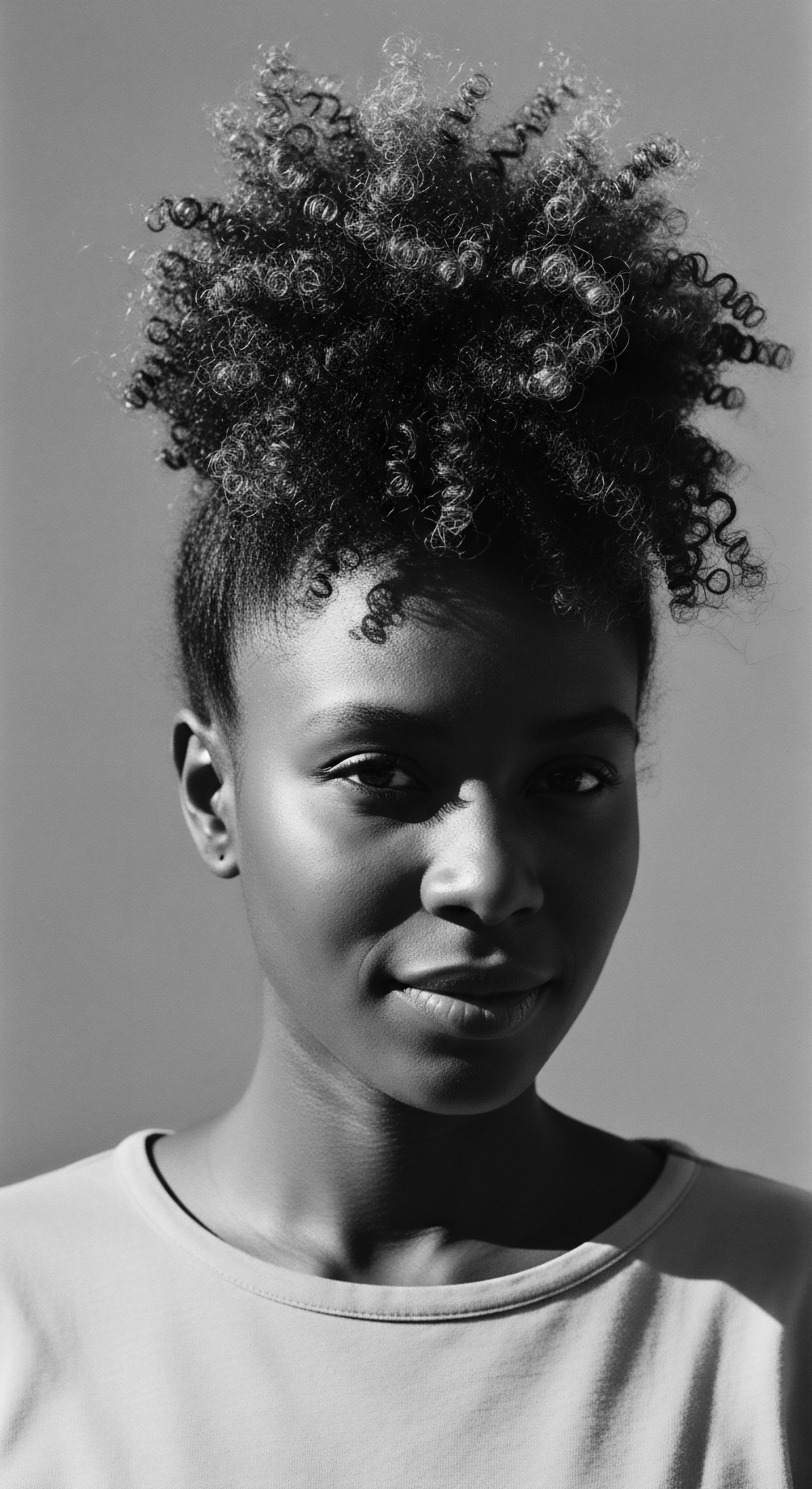
Reflection
To contemplate textured hair and its interaction with the sun is to gaze into a profound mirror, reflecting not only biology but also millennia of human adaptation , resilience, and cultural expression. Each coil and wave holds stories, whispered across generations, of survival under vast, open skies. The seemingly simple question of whether textured hair offers sun protection unravels into a rich tapestry of ancestral knowledge , biological ingenuity, and the tender care passed down through the ages.
Our journey through the intrinsic structures, the time-honored rituals, and the burgeoning scientific understanding reveals a truth often understood implicitly by our forebears ❉ textured hair, in its magnificent variations, is more than just strands; it is a legacy. It is a crown that intrinsically carries a degree of defense against the very elements that shaped early human existence. The deeply pigmented cortex, the unique, light-scattering geometry of the curls, and the communal density they form all speak to an inherited wisdom , a silent testament to the ingenuity of life itself.
The hands that meticulously braided hair for protection, the communities that shared knowledge of shea butter’s soothing embrace, and the cultures that celebrated the regal dignity of a well-wrapped head—all were engaging in practices that, while often spiritual or social, were profoundly practical. These were acts of preservation, not just of physical hair, but of cultural identity and collective well-being. Modern science merely offers a new language to articulate what was long known through lived experience and tradition.
As we move forward, a deeper reverence for textured hair means recognizing its profound connection to its past, understanding its inherent capabilities, and honoring the ancestral practices that nurtured it. The ‘Soul of a Strand’ whispers of this unbroken lineage, reminding us that in understanding our hair, we also come to understand a part of our shared human heritage —a story written in the very fibers that spring from our scalp, endlessly guarding, endlessly inspiring, endlessly connecting us to the source.

References
- Robbins, C. R. (2012). Chemical and Physical Behavior of Human Hair (5th ed.). Springer.
- Du Bois, W. E. B. (1903). The Souls of Black Folk. A. C. McClurg & Co.
- Porter, J. C. & Harmon, C. (1971). Textile Science ❉ An Introductory Text. Merrill Publishing Company.
- Cashin, E. F. (2000). African Americans in the Colonial Era. University of North Carolina Press.
- De la Mettrie, J. O. (1748). Man a Machine. Open Court Publishing Company. (Considered for early views on biological adaptations).
- Palmer, G. C. (2013). Hair in African Art and Culture. Museum for African Art. (Explores cultural significance and styling).
- Sweet, J. (2006). The Hair and Scalp and Their Disorders. CRC Press.
- Hunter, P. (1987). The Science of Hair Care. Marcel Dekker.
